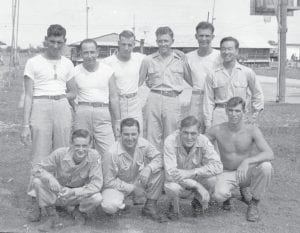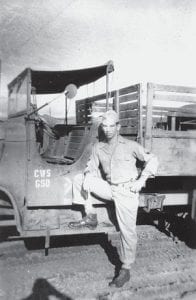Above: Leonard Sobanja with a group of friends at his post near Manila in the Philippines. Sobanja is the young man on the right with no shirt on. He swam nearly every day while stationed there and entered the “South Pacific Olympics.” Right: Leonard Sobanja with one of the Army vehicles he used during his tour of duty. Sobanja had a wide variety of jobs during his time in the Philippines.

Leonard Sobanja had the opportunity to not serve in the military, when he was drafted in 1943. But the determined young man found a way. Now 88 years old, Sobanja laughed when he shared the experience with the Cook County News-Herald. “I don’t know why I tried so hard.”
When Sobanja was called up he didn’t pass the physical. “I flunked because of a hernia,” he explained.
He was determined to join the service, so he underwent surgery to fix the hernia. Once healed, in 1944, he applied to enter the Navy. He got orders to report for duty to Fort Snelling in January 1945, which he did, excited at the prospect of being a sailor. However, when he got there he was told he was being inducted into the Army. “One of my first lessons about how the service works,” chuckled Sobanja.
He was sent to Fort Leonard Wood, Missouri for basic training and then attended schooling at Camp Robertson in Little Rock, Arkansas. He managed a leave and came home to get married in June 1945, only to be sent off to Fort Ord, California for an unknown deployment.
However, Sobanja said shortly after he got to California, he “got lucky.” His wife, Louise, arranged a trip to a nearby town. Leonard was amazed to get a note from Louise telling him, “I’m here at Fort Ord.”
The couple was able to live off base and spent a few weeks together, but their time together was tenuous. Leonard was on alert to be shipped out at any time. He was assigned to a supernumerary company, which meant every time a unit was deploying, his company would also be called. They would stand ready as soldiers boarded a train. If a deploying unit didn’t have enough people to fill the train, soldiers would be taken from his company. Several times Leonard was alerted and had to say goodbye, not knowing if he would be returning to his wife that evening or not.
Sadly the day finally came and it was Sobanja’s turn to ride the train to San Francisco. There he and hundreds of men boarded a Liberty Ship that had been converted for troop transport. It was crowded and uncomfortable, with bunks only about 5½ feet long, stacked six high. They sailed out of San Francisco harbor, destination unknown.
“The worst part,” recalled Sobanja, “was when someone got sick.” And a lot of people got sick when the Liberty Ship neared the Continental Shelf where land swells caused the ship to really rock. “I spent my first night on deck, sleeping on a canvas hold cover.”
Despite being surrounded by water there was not enough water for bathing, so when the men saw a storm approaching, they hurried for soap and showered on deck in the rain. “You had to hurry though, because you never knew how long the rain would last.”
Sobanja said the men got two meals a day on the ship— most of them consisting of two slices of bread and a thick slice of Spam.
The miserable trip continued for over 40 days, eventually finishing in Pearl Harbor. Sobanja said it appeared that Pearl Harbor had been greatly rebuilt, but the soldiers were not allowed to disembark. They were soon off to sea, once again to another destination unknown.
While Sobanja’s company was on the ocean, they learned that two atomic bombs had been dropped on Japan. The first, Sobanja learned, fell on Hiroshima on August 6, 1945 when he was on the train to San Francisco. The second, on Nagasaki on August 9, fell while his ship was at sea. The war was officially over.
However, that did not mean Sobanja’s tour of duty was finished. The ship traveled on to the Philippines, docking at Clark Field on Luzon Island. Sobanja said they were assigned to the “Repo Depo” and served as replacements for soldiers being sent home after being there for two to three years. Sobanja was assigned a variety of odd jobs.
He was sent to a company in Kaison City, a rural suburb of Manila. His unit’s mission was to clear trees in the jungle to build a new company area. It was hard, dirty work, Sobanja recalled. His work, group once got a military 6×6 truck stuck so deep in the mud that they had to get another truck to pull it out—and it pulled the frame right off the chassis.
Sobanja transported construction workers, and he was called on to set up a box factory that would package and ship the rubber from disassembled gas masks to the United States.
That was not the case with many other pieces of military equipment. Sobanja said there was a great deal of waste. He said trucks and jeeps were driven into the ocean. For a time his job was loading ammunition onto an LCT, heading out of Manila Bay to sea and dumping the ammo overboard.
When off-duty, the soldiers explored the area and sometimes found wartime souvenirs. That practice came to an abrupt stop when a soldier picked up a Japanese revolver—and his hand was blown off. It had been booby-trapped.
Sobanja said there were Japanese soldiers hiding in the jungle, unwilling to surrender. They didn’t try to hurt Americans. But Sobanja said they would sneak into camp and rummage through the garbage, seeking food and clothing.
Sobanja said their condition was disheartening, as was the condition of some prisoners from Formosa (now Taiwan) that he was assigned to guard. About 20 soldiers traveled to Formosa on a Merchant Marine ship with the prisoners. He recalled that one fellow “went crazy.” He said the prisoner started running around the ship screaming “Banzai!” and trying to attack people. “He was in such poor shape, so emaciated, he couldn’t do any harm,” said Sobanja.
He recalled that the captain couldn’t wait to get the prisoners off his ship, as they were so sick and dying. Sobanja said it was terrible to see the aftermath of war.
But there were times that made it almost worthwhile. Sobanja said it was exciting to be there when General MacArthur met with the Japanese peace envoy in Manila.
Sobanja was there when the Philippines was granted home rule. He remembers that U.S. Secretary of State Cordell Hull was there. Sobanja said it was a moving ceremony to see the honor guards simultaneously lower the U.S. flag and raise the flag of the Philippines.
In addition to being present for such historic occasions, Sobanja got a lot of exercise. Across the road from his quarters was a swimming pool, so he swam every day. He heard about the “South Pacific Olympics” and signed up for the 100-yard freestyle. The competition was against the various branches of the service. Sobanja represented the Army well. He grinned and said, “I took second place.”
When Sobanja completed his tour, he returned to the United States by ship again, but this time it was an Army Transportation Corps ship which was not so crowded and uncomfortable. It took about a week on the nicer ship to reach San Francisco and Sobanja clearly recalls the jubilation when the ship passed under the Golden Gate Bridge. He processed out in Oakland and one of the best things about that base was that they welcomed the returning soldiers with a big steak dinner—“cooked anyway you wanted.”
Sobanja was discharged in October 1946 and headed back to the Midwest to his bride and to attend college. “The nicest part of the whole thing was that I got my education paid for. The GI Bill was the best thing that ever happened to this country,” he said.
Sobanja earned a teaching degree and ultimately certification to be a principal, eventually serving that role at Cook County High School—something the Army somewhat helped him prepare for.
So, looking back, would he try so hard to enlist again? Sobanja said he would. “I’d say yes. It has its hazards. I was very lucky. But you learn a lot. One thing about the service, you learn how to get by, no matter what happens.”



Loading Comments